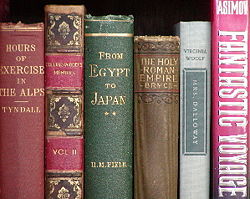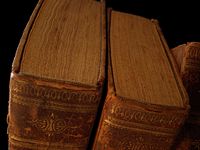Book Collecting
 From Nwe
From Nwe 
Book collecting is the collecting of books, including seeking, locating, acquiring, organizing, cataloging, displaying, storing, and maintaining books that are of interest to a an individual collector. The love of books is bibliophilia, and someone who loves to read, admire, and collect books is a bibliophile. Bibliophilia is sometimes called bibliomania but should not be confused with the obsessive-compulsive disorder by that name, which involves the excessive accumulation and hoarding of books. A book dealer is one whose profession is the buying and reselling of rare or used books.
Book collecting can be easy and inexpensive: there are millions of new and used books, and thousands of bookstores, including online booksellers like Abebooks, Alibris, and Amazon. Only the wealthiest book collectors pursue the great rarities: the Gutenberg Bible, and Shakespeare's First Folio, for example, are both famous and extremely valuable. Collectors of average means may collect works by a favorite author, first editions of modern authors, or books on a given subject. Book prices generally depend on the demand for a given book, the number of copies available, and their condition.
History

Europe
Book collecting is distinct from casual book ownership and the accumulation of books for reading. It can probably be said to have begun with the collections of illuminated manuscripts, both commissioned and second-hand, by the elites of Burgundy and France in particular, which became common in the fifteenth century. Duke Philip the Good of Burgundy appears to have had the largest private collection of his day, with about six hundred volumes. With the advent of printing with movable type books became considerably cheaper, and book collecting received a particular impetus in England and elsewhere during the Reformation when many monastic libraries were broken up, and their contents often destroyed. There was an English antiquarian reaction to Henry VIII's dissolution of the Monasteries. The commissioners of Edward VI plundered and stripped university, college, and monastic libraries, so to save books from being destroyed, those who could began to collect them.
China

The history of book collecting in China dates back over two millennia. The first important effort to collect books in China was made during the early Han Dynasty by the government, as many important books were burned during the Qin Dynasty. From then on, book collecting began to flourish in China, particularly after the invention of block printing during the early Tang Dynasty, with both imperial and private collections blooming throughout the country. However, the systematic study of book collecting began only during the Qing Dynasty.
Terminology
- Cangshulou (Chinese: 藏書樓 "book collecting tower"): library, such as the private Tianyige (天一閣) in Ningbo, the earliest surviving library in China, or the imperial Wenyuange (文淵閣), where the works collected in Siku Quanshu were reposited
- Jinxiangben (巾箱本 "headscarf box edition"): ancient pocket edition
- Jiupingzhuang (舊平裝 "old paperback") or Jiushu (舊書 "old books"): old books published after 1911, when the Qing Dynasty was overthrown
- Maobianben (毛邊本 "hairy-side edition"): uncut editions
- Songben (宋本 "Song edition") or Songban (宋版 "Song edition"): block printed books published during the Song Dynasty, highly valued by collectors
- Xianzhuangshu (線裝書 "thread-bound book"): thread-bound books, usually referred to those published before 1911
Genres, themes, and interests
Book collectors often specialize in one or more genres or sub-genres of literature. For example, a reader of fiction, who enjoys Westerns, might decide to collect first editions of Zane Grey's novels. A lover of modern English poetry might collect the works of Dylan Thomas. A Californian who prefers non-fiction might look for books about the history of the San Francisco Bay Area.
Individual interests may include:
- A particular author
- A particular genre or field (science, medicine, history, etc)
- A particular illustrator
- Award winning books
- Books as Art
- Bindings and/or Book design
- Comic books and Graphic novels
- Cover or dust jacket art
- First editions
- Fore-edge paintings
- Illustrated books
- Incunabula: books printed before 1501
- Local/Regional interests
- Marginalia
- Miniature books
- The publisher and/or printer
- Fine press books
- Private press books
- Small presses
- Paper, parchment, or vellum
- Series
- Photoplay editions
- Signed books: inscribed/signed by an author or illustrator
- Stages of publication: advance review copies, galley proofs
Related collecting interests include collecting autographs.

Prices
Book prices generally depend on the demand for a given book, the number of copies available for purchase, and the condition of a given copy. As with other collectibles, prices rise and fall with the popularity of a given author, title, or subject.
eBay, and online booksellers like Abebooks, Alibris, and Amazon have profoundly affected the prices of new and used books, generally reducing them. Commercial and private sellers list unused copies of many books that are still in print at their list prices for as little as one cent.
Because of the huge number of books for sale, there is no single comprehensive price guide for collectible books. The prices of the copies listed for sale at the online bookseller sites provide some indication of their current market values.
Condition

As with other collectibles, the value of a book ultimately depends on its physical condition. Years of handling, moving, and storage take their toll on the dust jacket, cover, pages, and binding. Books are subject to damage from sunlight, moisture, and insects. Acid from the papermaking process can cause the pages to develop brown spots, called foxing; gradually turn brown, called tanning; and ultimately crumble.
Common defects include general wear; jacket/cover edge wear, scratches, and tears; the previous owner's written name, bookplate, or label; soil and stains; dogeared pages; underlining, highlighting, and marginalia; water damage; torn hinges, endpapers and pages; and pages, illustrations, or whole signatures free of the binding, or missing entirely.
A book in good condition should be a rectangular solid when at rest, whether upright or on its back, with the covers at right angles to the spine. If a book is out of square, usually from resting crooked on a shelf, or leans to the right or left when on its back, it is cocked, or shelf-cocked. If the covers bend in or flare out, usually from rapid humidity changes, a book is bowed (bent like a drawn bow). Thick hardbound books also tend to have their pages sag downward in the middle even if they are sitting level on a shelf.
Sources
New books are readily available from bookstores and online. Many bookstores specialize in out-of-print, used, antiquarian, rare and collectible books. Online booksellers, including Abebooks, Alibris, and Amazon, encourage other stores and individuals to sell books through their websites, and charge a commission.
Antique and collectible stores may have a few books for sale. Major auction houses sell quality collectible books, and local auction houses may sell books by the carton. Thrift shops and second-hand stores commonly have book sections. Other sources include estate, yard, garage, or rummage sales and charity fund-raisers.
Prominent book collectors
- Anthony Collins
- Thomas Jefferson
- Adam Smith
See also
- Auction
- Book selling
- Book
- Bookbinding
- Manuscript
- Private library
References
ISBN links support NWE through referral fees
- Ahearn, Allen and Patricia. Book Collecting: A Comprehensive Guide. New York: Putnam, 1995 ISBN 0-399-14049-2
- ———. Collected Books: The Guide to Values. New York: Putnam, 2001 ISBN 0-399-14781-0
- American Book Prices Current (Annual, 1894/1895 onwards).
- Carter, John. ABC for Book Collectors, 8th ed. edited by Nicolas Barker. New Castle, DE: Oak Knoll; London: British Library, 2004. ISBN 0-7123-4822-0 (British Library); ISBN 1-58456-112-2 (Oak Knoll) - a classic, first published in 1952.
- Carter, John. Taste and Technique in Book-collecting, with an Epilogue. Pinner, Middlesex: Private Libraries Association, 1970. (The Sandars Lectures in Bibliography, 1947) ISBN 0-900002-30-1
- Greenfield, Jane. The Care of Fine Books. New York: Lyons & Burford, 1988. ISBN 1-55821-003-2
- McBride, Bill. Book Collecting for Fun and Profit. Hartford, CT: McBride/Publisher, 1997. ISBN 0-930313-05-4
- ———. A Pocket Guide to the Identification of First Editions. 6th ed. Hartford, CT: McBride/Publisher, 2000. ISBN 0-930313-06-2
- ———. Points of Issue. 3rd ed. Hartford, CT: McBride/Publisher, 1996. ISBN 0-930313-04-6
- Peters, Jean (ed.). Book Collecting: A Modern Guide. New York and London: R.R. Bowker and Company, 1977. ISBN 0-8352-0985-7
- Rees-Mogg, William. How to Buy Rare Books: A Practical Guide to the Antiquarian Book Market. Oxford: Phaidon, 1985 (Christie's collectors guides). ISBN 0-7148-8019-1
- Wilson, Robert A. Modern Book Collecting. New York: Lyons & Burford, 1992 ISBN 1-55821-179-9
- Zempel, Edward N. and Verkler, Linda (eds.). First Editions: A Guide to Identification, 4th ed. Peoria, IL: The Spoon River Press, 2001. ISBN 0-930358-18-X
Chinese
- (Chinese) 傅璇琮、谢灼华主编,《中國藏書通史》,宁波:宁波出版社,2001
- (Chinese) 焦树安,《中囯藏书史话》,北京:商务印书館,1997
- (Chinese) 任繼愈主編,《中國藏書樓》,沈阳:辽宁人民出版社,2001
- (Chinese) 黄燕生,《天祿琳琅:古代藏書和藏書樓 》,台北:萬卷樓圖書有限公司,2000
- (Chinese) 徐凌志主编,《中国历代藏书史》,南昌:江西人民出版社,2004
External links
All links retrieved February 8, 2022.
- The Alcuin Society - A voluntary association of people who care about the past, present and future of fine books]
- Collecting Books and Magazines: Authors and Artists Resource material for collectors of children's books and magazines
- Collegiate Book Collecting Championship Annual collegiate book collecting contest, promoting book collecting to the next generation
- Books and Book Collecting Information and resources for book collectors
- Conservation OnLine: Resources for Conservation Professionals A project of the Preservation Department of Stanford University Libraries
- Infography about Book Collecting A book collector's choice of the best books, articles, and online resources
Credits
New World Encyclopedia writers and editors rewrote and completed the Wikipedia article in accordance with New World Encyclopedia standards. This article abides by terms of the Creative Commons CC-by-sa 3.0 License (CC-by-sa), which may be used and disseminated with proper attribution. Credit is due under the terms of this license that can reference both the New World Encyclopedia contributors and the selfless volunteer contributors of the Wikimedia Foundation. To cite this article click here for a list of acceptable citing formats.The history of earlier contributions by wikipedians is accessible to researchers here:
- Book_collecting history
The history of this article since it was imported to New World Encyclopedia:
- History of "Book collecting"
Note: Some restrictions may apply to use of individual images which are separately licensed.
↧ Download as ZWI file | Last modified: 02/03/2023 22:54:29 | 64 views
☰ Source: https://www.newworldencyclopedia.org/entry/Book_collecting | License: CC BY-SA 3.0
 ZWI signed:
ZWI signed: KSF
KSF